
A meterstick is mounted horizontally above a turntable as shown. Identical metal washers are hung at the positions shown. The turntable and meterstick are then spun. Rank from greatest to least, the following quantities for the washers.
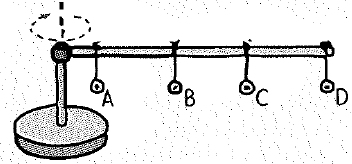
a. rotational speed
b. linear speed
c. angle the string makes with the vertical
d. inward force on each
e. outward force on each
(a)
To rank: The washer on the basis of rotational speed from greatest to least.
Answer to Problem 20A
The rank of the rotational speed from greatest to least is
Explanation of Solution
Introduction:
Rotational speed is the number of rotations per unit time and is also known as angular velocity. It is represented as
The given figure is shown below.
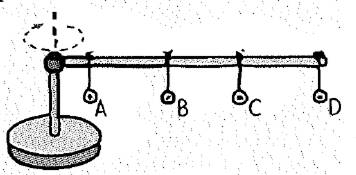
Identical metal washers are hung at the positions on a meterstick is mounted horizontally above a turntable.
The rotation of turn table rotates the metal washers in the meterstick at the same speed. Hence, the rotational speeds of the metal washers are same.
Conclusion:
Thus, the rank of the rotational speed from greatest to least is
(b)
To rank: The washer on the basis of the linear speed from greatest to least.
Answer to Problem 20A
The rank of the linear speed from greatest to least is
Explanation of Solution
Introduction:
The expression for the linear or tangential speed is,
Here,
Tangential speed is dependent on the distance from the axis of rotation and rotational speed.
The given figure is shown below.
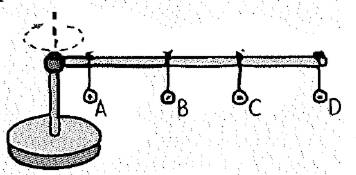
The linear speed and the radius of its circular path’ radius are directly proportional to each other.
The radius of the metal washer D is more when compared to the other washers.
The radius of the metal washer A is less when compared to the other washers.
So, the metal washer D’s linear speed is greater than the linear speed of the other washers.
Conclusion:
Thus, the rank of the linear speed from greatest to least is
(c)
To rank: The washer on the basis of angle that string makes with the vertical from greatest to least.
Answer to Problem 20A
The rank of the angle the string makes with the vertical from greatest to least is
Explanation of Solution
Introduction:
The force exerted on the system is directly proportional to the square of the tangential speed.
Linear speed varies with the distance from the axis of rotation.
The expression for the linear or tangential speed is,
Here,
The given figure is shown below.
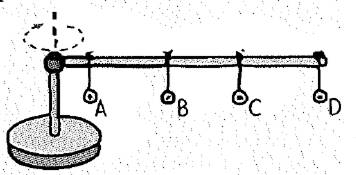
The linear speed is directly proportional to the radius of its circular path.
From part (b), the rank of the linear speed from greatest to least is
The radius of the metal washer D is more when compared to the other washers.
The radius of the metal washer A is less when compared to the other washers.
By comparing the values of the angle the string makes with the vertical is
Conclusion:
Thus, the rank of the angle the string makes with the vertical from greatest to least is
(d)
To rank: The washer on the basis of the inward force on each from greatest to least.
Answer to Problem 20A
The rank of the inward force on each from greatest to least is
Explanation of Solution
Introduction:
The expression for the centripetal force is,
Here,
The expression for the linear or tangential speed is,
Here,
The given figure is shown below.
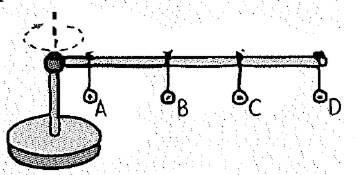 From part (b), the rank of the linear speed from greatest to least is
From part (b), the rank of the linear speed from greatest to least is
The centripetal force or inward force is directly proportional to the square of the linear speed.
By comparing the values of the linear speed, the centripetal force is
Conclusion:
Thus, the rank of the inward force on each from greatest to least is
(e)
To rank: The washers on the basis of outward force from greatest to least.
Answer to Problem 20A
The outward force is not there for the system.
Explanation of Solution
Introduction:
The expression for the centripetal force is,
Here,
The expression for the linear or tangential speed is,
Here,
The given figure is shown below.
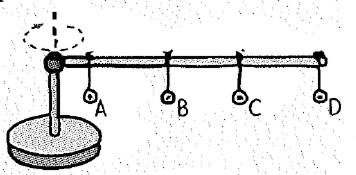
The centripetal force is the inward force and it is directly proportional to the square of the linear speed.
In the meterstick and turntable, there is only the centripetal or inward force act on the system.
So there is outward force doesn’t act on the system.
Conclusion:
Thus, outward force is not there for the system.
Chapter 10 Solutions
CONCEPTUAL PHYSICS-W/PRACTICING PHYSICS
Additional Science Textbook Solutions
College Physics: A Strategic Approach (3rd Edition)
Cosmic Perspective Fundamentals
Microbiology: An Introduction
Chemistry: A Molecular Approach (4th Edition)
Campbell Essential Biology (7th Edition)
Human Anatomy & Physiology (2nd Edition)
- A = 45 kN a = 60° B = 20 kN ẞ = 30° Problem:M1.1 You and your friends are on an archaeological adventure and are trying to disarm an ancient trap to do so you need to pull a log straight out of a hole in a wall. You have 1 rope that you can attach to the log and there are currently 2 other ropes and weights attached to the end of the log. You know the force and direction of the ropes currently attached are arranged as shown below what is the magnitude and direction 'e' of the minimum force you need to apply to the third rope for the force on the log to be in direction of line 'a'? What is the resultant force in direction 'a'? a ////// //////arrow_forwardanswer both questionsarrow_forward- 13- 3. Shastri recalled reading that for an ideal transformer, "the ratio of the primary voltage to the secondary voltage is equal to the ratio of the secondary current to the primary current." Plan and design an experiment to investigate whether the statement above is true. (8) • With the aid of a fully labelled circuit diagram, describe a procedure which can be used to investigate whether the statement is true. The circuit diagram must include the following components: A variable AC voltage supply • AC voltmeters • AC ammeters A transformer with adjustable turns ratio Connecting wires • ° A load resistorarrow_forward
- sunny (1) -13- end. One box contains nothing inside; one has a piece of resistance wire between the terminals You are provided with three sealed identical matchboxes labelled A, B and C, with terminals at each and the other, a semi-conductor diode. Plan and design an experiment to identify the contents of each box. You are provided with the following elements for your apparatus: Ammeter Low voltage power supply Connecting wires Labelled circuit diagram Draw a well-labelled circuit diagram to show how you would connect the apparatus listed above to each matchbox. (3 maarrow_forwardRAD127 Radiographic Equipment and Computers SI Units in Radiography Ch. 1 & 2 Instructions: Provide the units for each of the following in full and short forms 1. Mass - kg, 9 or (1b)) ・ 2. Energy, Work - W = FD,J 3. Air kerma -(Gya) 4. Absorbed Dose- 5. Effective Dose J/kg (94+) jlkg J/kg, Sv 6. Radioactivity - 5-1, Bq 7. Weight 8. Time 9. Force 10. Power B9 wt, wt-mg, N -(s) F= ma, N, OR 1b. (JIS), P= work It = Fdlt, Jarrow_forwardanswer 1-8arrow_forward
- 1 . Solve the equation 2/7=y/3 for y. 2. Solve the equation x/9=2/6 for x. 3. Solve the equation z + 4 = 10 This is algebra and the equation is fraction.arrow_forwardtwo satellites are in circular orbits around the Earth. Satellite A is at an altitude equal to the Earth's radius, while satellite B is at an altitude equal to twice the Earth's radius. What is the ratio of their periods, Tb/Taarrow_forwardFresnel lens: You would like to design a 25 mm diameter blazed Fresnel zone plate with a first-order power of +1.5 diopters. What is the lithography requirement (resolution required) for making this lens that is designed for 550 nm? Express your answer in units of μm to one decimal point. Fresnel lens: What would the power of the first diffracted order of this lens be at wavelength of 400 nm? Express your answer in diopters to one decimal point. Eye: A person with myopic eyes has a far point of 15 cm. What power contact lenses does she need to correct her version to a standard far point at infinity? Give your answer in diopter to one decimal point.arrow_forward
 College PhysicsPhysicsISBN:9781305952300Author:Raymond A. Serway, Chris VuillePublisher:Cengage Learning
College PhysicsPhysicsISBN:9781305952300Author:Raymond A. Serway, Chris VuillePublisher:Cengage Learning University Physics (14th Edition)PhysicsISBN:9780133969290Author:Hugh D. Young, Roger A. FreedmanPublisher:PEARSON
University Physics (14th Edition)PhysicsISBN:9780133969290Author:Hugh D. Young, Roger A. FreedmanPublisher:PEARSON Introduction To Quantum MechanicsPhysicsISBN:9781107189638Author:Griffiths, David J., Schroeter, Darrell F.Publisher:Cambridge University Press
Introduction To Quantum MechanicsPhysicsISBN:9781107189638Author:Griffiths, David J., Schroeter, Darrell F.Publisher:Cambridge University Press Physics for Scientists and EngineersPhysicsISBN:9781337553278Author:Raymond A. Serway, John W. JewettPublisher:Cengage Learning
Physics for Scientists and EngineersPhysicsISBN:9781337553278Author:Raymond A. Serway, John W. JewettPublisher:Cengage Learning Lecture- Tutorials for Introductory AstronomyPhysicsISBN:9780321820464Author:Edward E. Prather, Tim P. Slater, Jeff P. Adams, Gina BrissendenPublisher:Addison-Wesley
Lecture- Tutorials for Introductory AstronomyPhysicsISBN:9780321820464Author:Edward E. Prather, Tim P. Slater, Jeff P. Adams, Gina BrissendenPublisher:Addison-Wesley College Physics: A Strategic Approach (4th Editio...PhysicsISBN:9780134609034Author:Randall D. Knight (Professor Emeritus), Brian Jones, Stuart FieldPublisher:PEARSON
College Physics: A Strategic Approach (4th Editio...PhysicsISBN:9780134609034Author:Randall D. Knight (Professor Emeritus), Brian Jones, Stuart FieldPublisher:PEARSON





